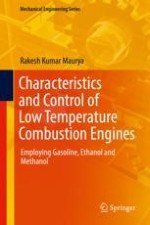2018 | OriginalPaper | Chapter
8. Emission Characteristics
Author : Rakesh Kumar Maurya
Published in: Characteristics and Control of Low Temperature Combustion Engines
Publisher: Springer International Publishing
Activate our intelligent search to find suitable subject content or patents.
Select sections of text to find matching patents with Artificial Intelligence. powered by
Select sections of text to find additional relevant content using AI-assisted search. powered by
